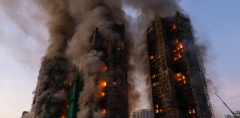At least 44 people have died and more than 270 are missing after a major fire engulfed an apartment complex in Hong Kong’s Tai Po district. The fire, which swept through multiple high-rise towers, is still burning.
The exact cause of the blaze, which broke out just before 3pm local time on Wednesday, is still unknown. Hong Kong Police have arrested three construction company executives on suspicion of manslaughter.
The apartment blocks are 31 stories tall. Opened in 1983, they were undergoing renovations at the time of the blaze, and were covered in bamboo scaffolding and green protective mesh.
Bamboo scaffolding has been a feature of the city for centuries. But why? The answer is part history, part engineering and part economics.
But the recent tragedy has sharpened the focus on fire safety, and when and where bamboo should be used.
A fast-growing grass
Bamboo is a fast-growing grass with hollow, tube-like stems (known as “culms”). Those tubes give it a high strength-to-weight ratio. A pole is light enough to carry up a stairwell, yet strong enough, when braced and tied correctly, to support platforms and workers.
Crews lash poles together in tight grids and tie them back to the buildings with brackets and anchors. Properly designed, a bamboo scaffold can resist wind and working loads.
Hong Kong’s Buildings Department and Labour Department publishes clear guidelines on the design and construction of bamboo scaffolds.
Bamboo scaffolding is also used in parts of mainland China, India, and across Southeast Asia and South America.
A cheap and flexible material
There are three main reasons why bamboo scaffolds are used in Hong Kong.
First, speed. An experienced team can “wrap” a building quickly because poles are light and can be cut to fit irregular shapes. That matters in tight streets with limited crane access.
Second, cost. Bamboo is a fraction of the price of metal systems, so contractors can keep bids low. The material is also easy to source locally, which keeps routine repairs and repainting within budget.
Third, tradition and skills. Bamboo scaffolding features in a famous piece of Chinese art, Along the River During the Qingming Festival, painted by Zhang Zeduan who lived between 1085 and 1145. Hong Kong still trains and certifies bamboo scaffolders, and the craft remains part of the city’s construction culture.
These factors explain why bamboo has remained visible on the city’s skyline even as metal systems dominate elsewhere.
Unlike metal made in blast furnaces, bamboo also grows back, and turning a stalk into a pole takes little processing. This means its overall climate impact is smaller.
What are the risks?
There are two main risks of bamboo scaffolding.
The first, as this tragedy in Hong Kong highlights, is fire.
Dry bamboo




